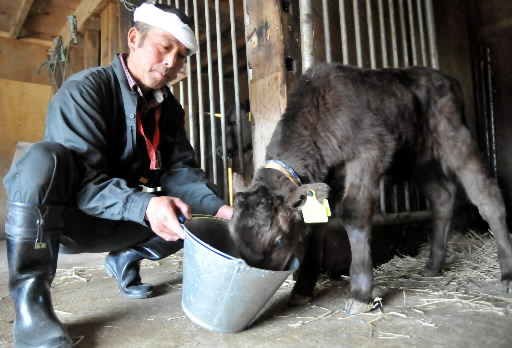Fukushima and Hiroshima: Frightened Ground, Part 1 [3]
May 25, 2011
Article 3: Village of livestock industry
by Yoko Yamamoto, Staff Writer
Milk from cows is discarded every day
“People should be evacuated immediately.” Satoru Endo, a specialist in energy technology and associate professor at the Faculty of Engineering at Hiroshima University, was shocked by the reading shown in his Geiger counter, a device used to measure radiation levels.
At the end of March, Professor Endo, along with Tetsuji Imanaka, a research associate at Kyoto University Research Reactor Institute, who specializes in nuclear engineering, and others, entered the village of Iitate in Fukushima Prefecture to investigate radiation levels in this area. Radioactive particles have been carried to this village by the wind, about 40 kilometers northwest of the Fukushima No. 1 (Daiichi) nuclear power plant. At the time, the Japanese government was still under the assumption that the radioactive particles were spreading in a concentric fashion, and considered sites 40 kilometers from the plant to be safe.
Through measurements of the radiation levels in the soil, up to 4.06 million becquerels of cesium per square meter was detected, about seven times the amount that was used as a standard for designating a site off-limits at the time of the nuclear accident at Chernobyl 25 years ago.
Hotspots
“Hotspots” are areas where radioactive particles are particularly heavy. A similar phenomenon took place in Chernobyl and Hiroshima as well. In Hiroshima, the “black rain” fell in the aftermath of the atomic bombing.
The contaminated grass has hit the livestock industry of Iitate hard. “I have to milk the cows and then dump the milk, over and over,” said Kenichi Hasegawa, 57, a dairy farmer in the village. “I can't stand it.” He has been forced to discard the milk in his fields every day, as the Japanese government has banned shipments of raw milk from cows in the area. He eyed a cow whose ribs protruded from its chest and said bitterly, “This colorless, invisible radiation is destroying my life.”
An analysis by Professor Endo disclosed the possibility that there may have been a spot in the village where people were exposed to radiation of “five millisieverts a day” as of March 15. The calculation leads to the assumption that, in 20 days, the doses of radiation suffered by people at this spot exceeded 100 millisieverts, the amount which is believed to raise the risk of cancer. Asked by a resident of the village if it was safe to remain in town, Professor Endo replied: “If I were you, I would evacuate my children.”
The village has been designated a “planned evacuation area,” with the evacuation starting on May 15. On May 8, Norio Kanno, the head of the village, pressed Katsuya Okada hard when the secretary general of the Democratic Party of Japan visited the village office. “Please carry out a national project to remove contamination from the soil, using our village as your base,” Mr. Kanno said. His remark was prompted by a strong sense of crisis that the ties binding the villagers will unravel if the evacuation of the entire village is prolonged.
“I can’t leave them behind”
“I plan to stay,” murmured Tokue Hosokawa, 59, while feeding a calf. Mr. Hosokawa runs a farm of livestock that has been in his family since his parents' generation. He now looks after more than 300 horses and cows after pleadings by farmers and others who evacuated earlier. A large number of cows have been in a frail state when giving birth to their calves and subsequently died. “Maybe they can't talk, but they're members of my family,” Mr. Hosokawa said. “I can't leave them behind. I'll never give in to this radiation.”
Professor Imanaka pointed out: “Internal exposure to cesium will present a problem from this point forward. We need a system by which residents can regularly check cesium.” Professor Imanaka has been working swiftly to create an indicator of radiation exposure designed for the residents of the affected areas. “The residents will make their decisions whether to leave or stay,” he said. “Our job is to do all we can and provide them with an indicator that will assist them in making this decision.”
(Originally published on May 18, 2011)








